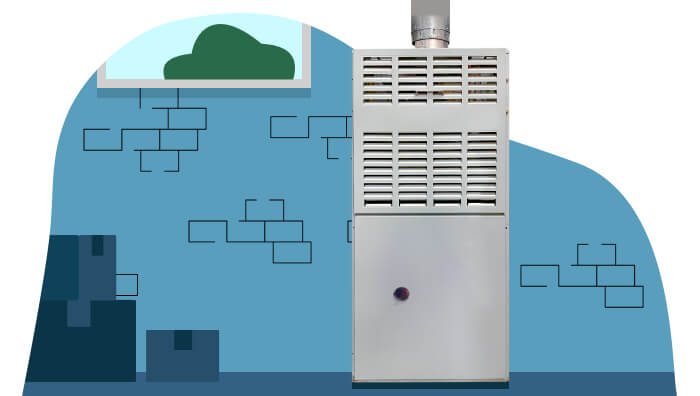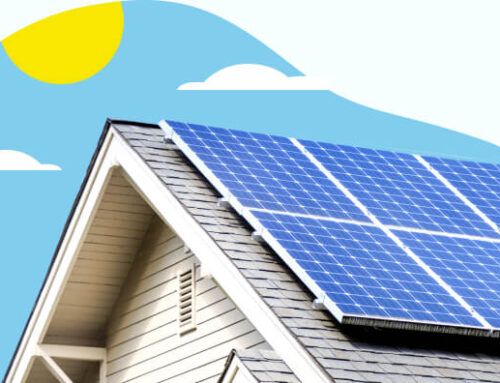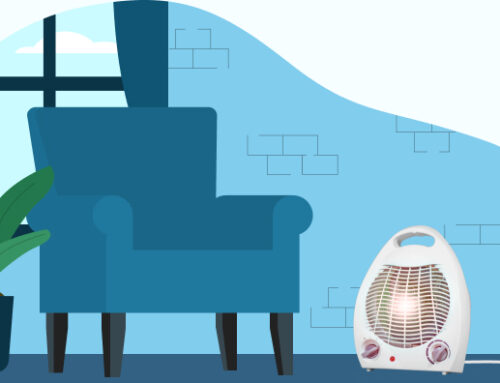Energy Consumption & Cost of Running Electric and Gas Furnaces
by Tyler Castle
17.7 min read

For many homeowners, heating costs are among the biggest annual expenses, especially due to fluctuations with the price of electricity and gas. With heating costs increasing in recent years, finding a more efficient way to stay warm is a high priority.
So, if you’re looking for ways to lower your heating bill, what’s the most effective furnace fuel option? Of the three types of available furnaces, we’re going to overlook oil furnaces — as they’re widely considered the least efficient and use the most expensive fuel type. But what about electric vs. natural gas furnaces?
This post compares both to see which might save you money — if you use them the right way.
What is the difference between a gas and an electric furnace?
As the names indicate, gas furnaces use natural gas or propane as a fuel source while electric furnaces run entirely on electricity.
Here’s how it works. When a gas furnace turns on, fuel is delivered directly through a natural gas line to a special valve inside the furnace that directs it into a burner. There, the gas is ignited to start a controlled flame. As the gas burns, it warms the air in the furnace’s heat exchanger, which in turn warms the cold air that the furnace blows across the outer surface of the heat exchanger. That warm air is then circulated through the house by the furnace blower through a series of metal air ducts.
Electric furnaces, in contrast, don’t burn fuel. Instead, they work similarly to how a hair dryer operates, by using electricity to warm up heating elements that, in turn, warm the surrounding air. The furnace’s blower brings in cold air to warm it up and then pushes the air back out through your house’s ductwork.
While both furnace types use different kinds of fuel, they both actually run on electricity. Gas furnaces need electricity to ignite the burner, and will use electricity to operate other components such as the blower fan, inducer fan, and any electronic controls. However, a gas furnace uses much less electricity when compared to an electric furnace.
Some other differences to be aware of:
- Gas furnaces produce heat faster and hotter than electric furnaces, allowing them to heat the air more efficiently. That efficiency, plus the lower cost of natural gas compared to other types of fuel, makes gas furnaces better for homes in colder climates.
- Though they won’t heat the house as effectively as a gas furnace, electric furnaces are considered more energy efficient in their fuel usage, as they have an annual fuel utilization efficiency (AFUE) of 95% to 100%. Gas furnaces burn fuel less efficiently, with high-efficiency furnaces rating in the 90’s, while older furnaces may drop to a much lower AFUE of 56% to 70%.
- Electric furnaces require less maintenance than most gas furnaces, making them less expensive to maintain over a longer period of time.
- One kilowatt hour of electricity produces 3,412 British thermal units, or the quantity of heat required to raise the temperature of one pound of water by one degree Fahrenheit. In comparison, one therm of natural gas equals 100,000 BTUs. That means, when you calculate the energy prices across every U.S. state, it will be much less expensive to create the same amount of heat using natural gas than to rely on electricity.
How do I know if my furnace is gas or electric?
Knowing whether your furnace is gas or electric is essential if you want to determine your overall energy usage. If you’re not sure about which type of furnace you have, there are a few signs you can look for which will indicate gas or electric.
- Gas furnaces use flames to burn fuel. If you have someone turn on the system while you’re monitoring it, you’ll see flames when you look through the furnace window and hear the tell-tale “whoosh” sound of the gas flame.
- Electric furnaces use heating coils, not open flames. So, there won’t be a furnace window, and you won’t see any sign of flames or hear any noise while it’s on.
- You can try to take a look inside by removing the filter on the furnace to see if you can spot either gas burners or electrical coils.
- You can also look at the labels on the furnace, which should state either voltage and kilowatts for an electric furnace or BTUs (British Thermal Units) if it’s a gas furnace.
- If a visual inspection doesn’t tell you enough, you could try running the brand name model through a Google search, or consult an HVAC technician.
What is a kilowatt hour and how does it determine your energy consumption?
Before we can determine how much energy either furnace type uses, we have to understand watts and kilowatt hours. Watts are the standard measurement rate of energy consumption, with one kilowatt (kW) equalling 1,000 watts.
A kilowatt hour (kWh) is the metric utility companies use to gauge how much electricity your residence uses over time — specifically, the amount of energy used to generate 1,000 watts of power for one hour. Your monthly electricity bill is based on how much your utility provider charges you per kWh. The rate will vary by your location, provider, and season — with certain times of year (such as winter) incurring higher utility rates due to increased demand from consumers.
For more information about kilowatts and kWh, visit our other blog post “What is a kilowatt-hour and why does it matter?”
How much energy does an electric furnace use?
An electric furnace uses electricity throughout its entire heating cycle. Every furnace will come with a wattage rating, which is the amount of electricity that the heater uses per hour. You can usually find the wattage listed on the product label, on the product packaging, or in the owner’s manual.
Most electric furnaces will use between 10 to 50 kilowatts (or 10,000 to 50,000 watts). If you’re looking for an average amount of kilowatts for your electric furnace, 20 kW is a good rule of thumb for most electric furnaces.
Also, furnaces aren’t running all the time (or at least they shouldn’t be), so they generally have a much lower “running” wattage than their stated wattage as they cycle on and off throughout the day.
In general, you can assume that a furnace will run 2-3 cycles an hour for 10-15 minutes in moderate temperatures. In colder temperatures, the cycles will be longer and occur more often. To get a fully accurate readout of your furnace you’ll need to average out how many cycles it runs in a day and how long they are.
To get some general cost estimates we’ll be doing some general calculations, and to keep things simple, we’ll assume that both gas and electric furnaces are running eight hours per day in winter.
How much energy does a gas furnace use?
Gas furnaces use propane or natural gas to produce heat, but they can’t run on gas alone. They do need electricity to operate.
Gas furnaces need a small amount of electricity to ignite (about 600 watts) as well as to operate the furnace blower, just like electric furnaces. When it comes to energy consumption, a gas furnace will draw the most power to the furnace blower. Depending on the efficiency of the blower and other components, a gas furnace can use anywhere from 75 watts to 400 watts while heating.
Gas furnaces use such a small amount of electricity, that to accurately measure their operating costs against electric furnaces, you’ll need to compare their fuel costs — i.e., how much electricity an electric furnace uses vs. how much natural gas a gas furnace uses. For an estimated calculation of this, keep reading!
Determining how many watts, amps, and volts a furnace uses
To determine your energy costs for an electric furnace, you need to know your kilowatt power use, how many hours per day you run it, and the price the electric company charges per kilowatt-hour.
If you don’t have the listed wattage for your furnace, then the simplest way to determine its wattage is to calculate it via the number of volts and amps.
- Volts (V): Short for voltage, volts measure the difference in electric potential between two points in an electrical circuit. This difference is what causes electric charges to flow to your appliances. Voltage tells you how much electrical potential the appliance needs to operate.
- Amps (A): Short for amperes, amps measure electrical current. The amperage rating tells you the number of electrons flowing through a circuit, which is how much electrical current the appliance draws.
Whether you need a 100-amp panel or a 200-amp panel for your furnace depends on the size of your home and your electrical use. In general, homes under 3,000 square feet or those using gas furnaces can get by with a 100-amp panel. Homes over 3,000 square feet and/or rely on electric heat will need a 200-amp panel to supply the necessary amount of power.
If you want to determine the energy usage of your furnaces, here are a few steps you can take.
- Check the furnace specifications: The manufacturer’s documentation or the furnace’s nameplate should provide information about its power requirements. Look for the electrical rating, which typically includes the voltage (120V, 240V) and the current (in amps or watts).
- Use a wattmeter: You can use a wattmeter or a power meter plugged into the furnace’s electrical outlet to measure its power consumption directly. This will give you an accurate reading of the actual power usage.
- Measure the current to estimate the wattage: You can measure the current drawn by the furnace using a clamp meter. Multiply the measured current by the voltage to get the power consumption in watts.
- Monitor electricity usage with a smart app: Some smart home energy monitoring systems can track the electricity usage of individual appliances over time.
The exact energy usage (and cost) of your furnace will depend if you have a single-stage or variable speed furnace. Single-stage furnaces only have one setting — on or off. Two-stage or variable-speed motors are able to operate at lower speeds to save on electricity.
Accounting for variable speeds will require a lot of additional assumptions, so to keep things simple for these estimates, we’ll assume a single stage furnace that’s operating at one speed. If you want a fully accurate readout of how many watts your furnace uses, you’ll need to use a clamp meter, wattmeter, or monitoring system.
How much does it cost to run a furnace?
Once you know your space heater’s kWH average for a span of time, you’ll need to multiply that value by the kWh usage rate charged by your utility company. For example, at the U.S. average cost of 16.21 cents per KwH, it would cost an average of $12.97 per day to run a 10 kW single-stage furnace for eight hours.
Here are some simple estimates of running different electric furnaces.
Cost to Run an Electric Furnace
(at U.S. Average of 16.21 cents per kWh)
| For 1 day (8 hours) |
For 1 week (7 days) |
For 1 month (30 days) |
For 1 winter (4 months) |
|
| 10,000 watts | $12.97 | $90.79 | $389.10 | $1,556.40 |
| 20,000 watts | $25.94 | $181.58 | $778.20 | $3,112.80 |
| 30,000 watts | $38.90 | $272.37 | $1,167.30 | $4,668.00 |
And here’s a comparison of electricity costs for different states based on their average kWh charges.
Cost to Run an Electric Furnace in Different U.S. States* for One Day
| Michigan 19.06 cents per kWh |
Pennsylvania 18.43 cents per kWh |
Ohio 16.01 cents per kWh |
Illinois 15.83 cents per kWh |
Indiana 15.17 cents per kWh |
|
| 10,000 watts | $15.25 | $14.74 | $12.81 | $12.66 | $12.14 |
| 20,000 watts | $30.50 | $29.48 | $25.62 | $25.32 | $24.28 |
| 30,000 watts | $45.75 | $44.22 | $38.43 | $37.98 | $36.42 |
*costs are based on EIA estimation of average kWH as of October 2023.
Those numbers are all pretty high, but remember that electric furnaces are used more in warmer climates, specifically states in the U.S. Southwest and Southeast. In those conditions, furnaces may only need to run for as little as one to two hours a day, instead of up to eight.
As for the cost of gas furnaces, while the energy usage of electric furnaces is measured by kilowatts (kW), the electric use of gas furnaces is negligible in comparison. Instead, the real cost calculation should be through natural gas consumption, which is measured in British thermal units (BTUs). A gas furnace will range between 75,000 to 100,000 BTUs an hour for high-efficiency units, while less efficient furnaces will use up to 150,000 BTUs an hour.
A therm is a measurement of the amount of heat energy in natural gas, equal to 100,000 BTUs. So, a gas furnace rated at 100,000 BTUs per hour will use one therm. According to the U.S. BLS, as of February 2024, the average residential price for natural gas was $1.465 per therm.
Cost to Run a Gas Furnace
(at U.S. Average of $1.452 per therm)
| For 1 day (8 hours) |
For 1 week (7 days) |
For 1 month (30 days) |
For 1 year (4 months) |
|
| 0.75 therm | $8.79 | $61.53 | $263.70 | $1,054.80 |
| 1 therm | $11.72 | $82.04 | $351.60 | $1,406.40 |
| 1.5 therms | $17.58 | $123.06 | $527.40 | $2,109.60 |
Keep in mind these are simplified calculations used mainly for comparison purposes. The actual amount of therms your gas furnace will use depends on how often it’s in use, its AFUE, and the size and insulation of your home.
According to the U.S. Energy Information Administration, the average national household uses 56.6 million British thermal units (MMBTUs) of natural gas for space heating — which is equivalent to 566 therms. In the Midwest region, newer homes with greater heat efficiency and better insulation consume an average of 48.9 MMBTUs, while older homes built before the 1950s consume an average of 74.8 MMBTUs.
If we multiply these annual usage rates against the latest EIA.gov annual natural gas prices, we get the following estimates:
Cost to Run a Gas Furnace in Different U.S. States* for One Year
(Based on Differing MMBTU Usage)
| Pennsylvania ($15.42) |
Ohio ($13.75) |
Indiana ($11.60) |
Michigan ($11.54) |
Illinois ($11.54) |
|
| 489 therms | $754.58 | $673.88 | $567.84 | $564.25 | $564.25 |
| 566 therms | $872.35 | $779.75 | $656.96 | $653.56 | $653.56 |
| 748 therms | $1,150.42 | $1,028.50 | $867.68 | $862.19 | $862.19 |
Is an electric furnace more or less expensive than a gas furnace?
Is it less expensive to use an electric or gas furnace? The answer depends on your location, the size of your house, the efficiency of your furnace, and local electricity and gas rates.
- Estimates for an average monthly heating bill throughout the contiguous U.S. states can range from as low as $30 a month in some southern states to as high as $168 a month in the Midwest.
- The larger your home, the more it costs to use central heat. If you need to heat an entire home, then a gas furnace will always be more “heat efficient.” However, if you’re heating only a small room for short periods at a time, an electric furnace could be an acceptable option.
- The higher a furnace’s annual fuel utilization efficiency, the less “waste” there will be to heat a space. An older gas furnace with a low 60% AFUE will lose 40% of its energy, meaning you’re burning more natural gas than if you had a higher efficiency. We should note that the Department of Energy has mandated that, as of 2028, all new gas furnaces must have an AFUE of 95%.
- And of course, as long as natural gas prices are lower than electricity rates, then a gas furnace will always be more cost-effective to operate over the same period of time. Check and compare your local gas and electricity rates to determine the specific cost differences in your area.
The bottom line is if you live in a climate with cold winters and need to heat an entire house, then a gas furnace will be much less expensive, as the cost of natural gas is cheaper than electricity.
However, if you live in a warmer climate with milder winters and only rarely need to use central heating, or are only heating a small apartment or single room, then it could be less expensive over the long term to install an electric furnace. In this case, you won’t need to worry about the additional costs of running natural gas lines, performing annual regular maintenance on the furnace, or losing AFUE efficiency over time.
FAQs
How many watts does it take to run an electric furnace?
The power consumption of an electric furnace depends on its size, efficiency, and the temperature it needs to reach. Typically, electric furnaces can range from around 10 kilowatts (kW) for smaller residential units to 50 kW or more for larger commercial or industrial furnaces.
How many watts does a natural gas furnace use?
A natural gas furnace uses some electricity to power components, such as the blower motor, ignition system, and controls, but uses significantly less than an electric furnace. The power consumption of a natural gas furnace typically ranges from around 300 watts to 800 watts, depending on the size and efficiency of the furnace.
How big of a generator do I need to run a furnace?
You’ll need to consider your furnace’s power requirements to determine the size of the generator needed to run it. Check the furnace’s specifications to see if it lists a starting wattage. If it doesn’t, you can use the rated wattage as a conservative estimate and add a safety margin of around 25% to 50% to accommodate any fluctuations or additional power needs.
Why does my furnace use so much electricity?
If you feel your furnace is using too much electricity, you may be running it too high or there may be efficiency issues. Check your thermostat settings; in the winter the ideal temperature setting should be between 68-70 degrees. Then, check your furnace, if it hasn’t had maintenance within the past year, schedule an appointment with an HVAC technician. Be sure to check the ductwork and electrical components to look for leaks and malfunctions.
How can I save on costs with my furnace?
Whether you’re using an electric or gas furnace, there are steps you can take to ensure your house is heated more efficiently. Here are some helpful tips you need to know to save on heating costs no matter which type of furnace you use.
- Purchase a furnace with a high efficiency rating. When buying a new furnace, check its annualized fuel utilization efficiency (AFUE) rating. The most efficient furnaces will have the Energy Star certification, which means their AFEU exceeds 90% , and they experience a lower percentage of energy loss as they heat up. While high-efficiency models tend to be more expensive to purchase, they will lead to lower utility bills and long-term savings.
- Schedule regular maintenance for your furnace. An annual maintenance checkup for your furnace will ensure it’s running as efficiently as possible. While it may be tempting to skip a year or two of maintenance, the longer your furnace operates without a tune-up, the less efficiently it will operate and the more you’ll be risking mechanical problems or breakdowns, which would result in higher energy bills and costly repairs.
- Check your air ducts. Furnaces transfer heat throughout your home’s ductwork, which is a series of metal ducts that circulate air in the home. If you have an older home, or think your furnace is using too much fuel, you may be losing heat through the ductwork. Ask a licensed HVAC technician to check that the ductwork was properly installed, to test if there are any leaks or blockages, and to inspect for any damages.
- Use a timer or settings to automatically set your furnace. If you’re running your furnace all day, you’re probably wasting fuel or electricity. Use a smart thermostat to establish automatic settings that will turn your furnace off after a set amount of time, when your home reaches a specified temperature, or even if you’re not at home.
- Supplement with a space heater. Rather than always relying on your furnace to heat the entire house, get an electric space heater to warm up just the room you’re using. A single space heater will be much less expensive to run than any furnace. Just know that, if you have to heat multiple rooms, it’s more efficient to heat the entire house rather than running multiple space heaters at the same time.
- Cover up while indoors during the winter months. Rely less on your heat during the winter months by dressing warmer while indoors. Wearing extra layers of clothing, socks, and slippers or throwing a couple of extra blankets on the bed to keep warm means you don’t need to set your central heating as high.
- Take the right steps to better conserve heat in your home. Besides dressing warmly, there are other ways to winterize your house and conserve heat. Purchasing heavy curtains, covering air leaks, and updating your insulation are the most efficient ways to save money on heating.
- Select an energy plan that fits with your lifestyle. If you want more control over your energy bill and don’t want to worry about spikes in your kWh charges, see if your retail energy provider offers Unlimited Energy or Fixed-Rate plans.Fixed-rate plans guarantee a cost that does not change for a specified period of time, while unlimited energy plans allow you to pay the same amount every month without worrying about fluctuating energy costs.*You can even choose Earth-Friendly Energy plans if you want to power appliances with renewable electricity plans or heat your home with carbon-neutral gas plans.
* Restrictions apply. Enrollment based upon program eligibility. Customers using more than 125% of normal monthly usage as determined by Santanna may be required to switch plans.
Tyler is an experienced energy professional, having worked for Santanna Energy Services, for the past four years. He is passionate about renewable energy and believes that diversifying the energy grid is the key to a sustainable future. Tyler is dedicated to supplying consumers with the best possible energy solutions and works diligently to make sure that Santanna can deliver the highest quality service.






